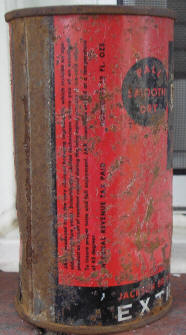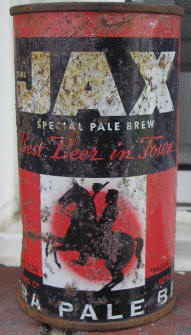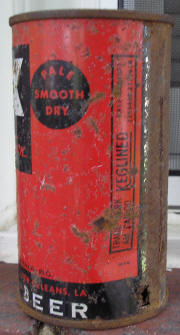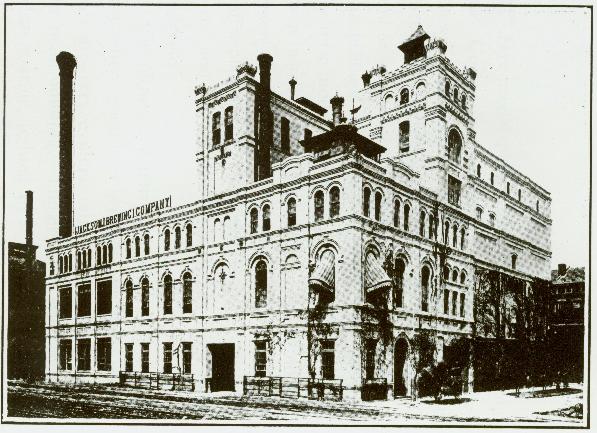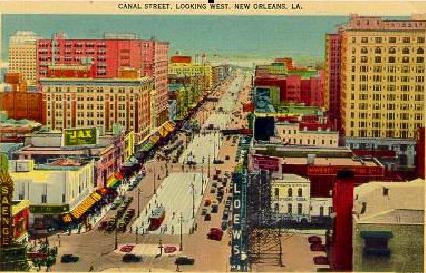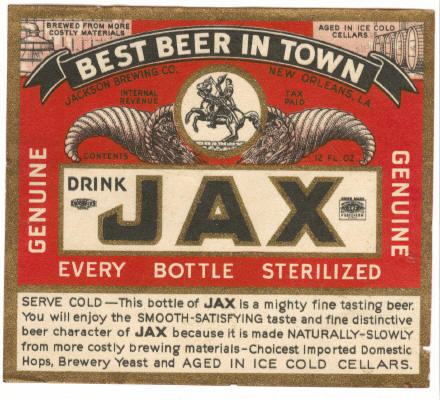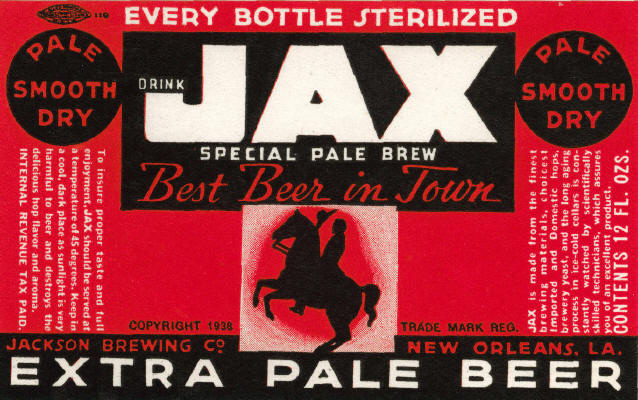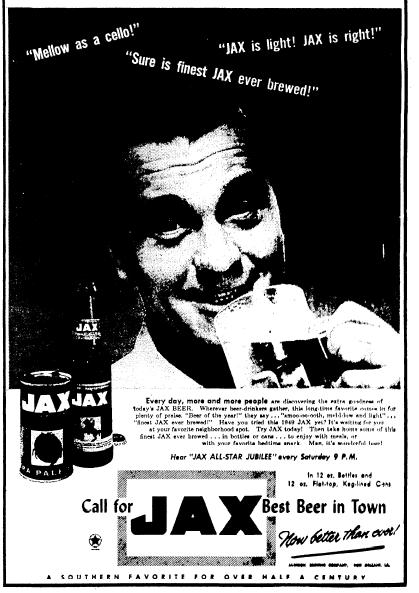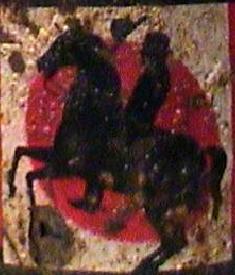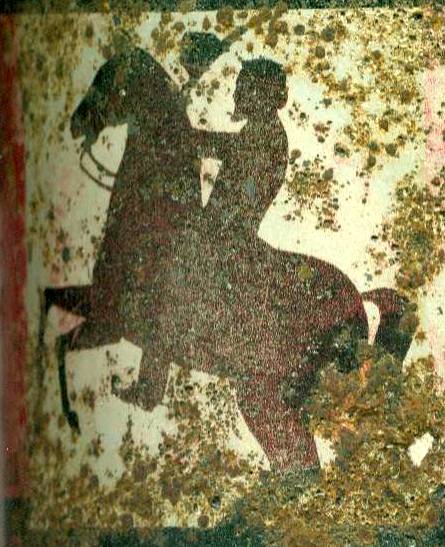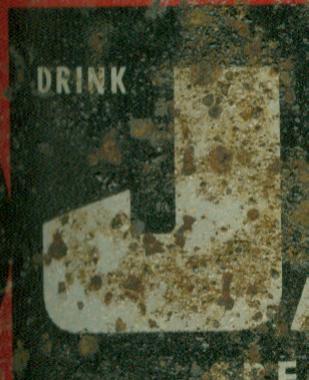Jax: circa 1949
“Hello Mellow Ja-ax little darlin’. You’re the beer for me. Yesireee.”
Three sides of the redesigned Jax label. Notice the seemingly missing arm on the statue of Andrew Jackson!
Jackson Brewing: 1890-1970
Jackson Brewing was founded by Lawrence Fabacher. His father was an Alsatian German immigrant who originally settled in Louisiana before the Civil War. Born on his parents’ plantation in 1863, Lawrence moved to New Orleans in 1880 and established Fabacher’s Restaurant on Royal Street. Highly successful as a restaurateur, he founded the brewery in 1890, and sold the restaurant to his brother, Peter. He built a five story brewery which took up the entire square between Jefferson, Decatur, St. Peter and Clay Streets. The brewery building was designed and constructed by German-born and educated architect Dietrich Einsiedel. While it used a deep well to find water for cleaning purposes, the water used in the beer was drawn from the Mississippi River and extensively filtered and boiled. Named after the hero of the Battle of New Orleans, Andrew Jackson, and basing its label on the local statue of the general, the brewery became a regional success. By the late 1930s it was sold in all of Louisiana, and parts of Texas, Arkansas, Oklahoma, Tennessee, Mississippi, and Alabama. During Prohibition the brewery stayed open but was producing only low-alcohol or "near" beer and soft drinks including a rootbeer.
Jackson Brewing, circa 1908.
New Orleans, Canal Street, circa 1940s. Note the Jax billboard to the left of Canal Street.
The can design came from a complete label redesign completed in 1938 on the eve of the brewery's 50th anniversary. The original label was very busy and distracting by the changing design standards of the 1930s. The designer, Martin Ullman, had done previous work for Stetson hats and American Chicle Chewing Gum. First he changed the shade of red by adding a strong orange tint so it wouldn't clash as much with the brown of the bottle glass. He then reversed the black on white letting for the brand name "JAX" to white on black which studies had shown was easier for customers to read. Then the information on the label was moved around into three columns. Studies had shown, according to the designer, that a consumer only saw one part of the label on a bottle at a time, so the center third held the most critical information, the brand name and the familiar logo of the Jackson statue. Each of the two side panels then could be used to hold other, less critical, information such as the spiel pictured below from the can side extolling the virtues of the brewery's brewing process. In addition, the Jackson logo was made much larger. While the can label was a little different from the bottle label, it retained most of Ullman's ideas and design. Only one side panel was changed, in order to allow for the addition of the canning company's "Keglined" box. (see the third photo of the can at the top of this page) They kept the design until sometime in mid 1950.
The old label (left) and the new (right).
I love how some old side panels extolled the many virtues of the beer. This one is from the third Jax can, but it reads the same as the panel on the earlier can.
The brewery remained in the family for three generations, and was for a time the largest independent brewery in the South and the tenth largest single-plant brewery in the country. It was sold in the late 1960s. Today the building is no longer a brewery, but has been turned into a shopping mall, with a museum on the second floor dedicated to the Jackson Brewing Company.
A Jax advertisement from 1949 with the red & black can. Mello as a cello???
Variations, or where's the arm?
There are at least three variations of this can. The first one is USBC 86-8, the one pictured above, which was issued in about mid 1949. The label designer made a mistake, however, and forgot to include Jackson's right arm. His hat appears to just be floating in the air above the horse's head! The funny thing is, the label was designed for bottled beer in 1938. But the missing arm was finally fixed when the next version of the can, USBC 86-9, added the arm back where it belongs, holding up the hat. This can appeared around late 1949. The third version, 86-10, is the same as 86-9, except that it is a non-IRTP can, meaning it was canned after March 1950. (There is supposed to be a red circle behind Jackson in the second can below, but the can is faded.) The can was completely redesigned in around April 1950 with a white and gold label. Even though all three of the red and black cans were issued for a short time, they are not rare, probably because the brand was so widely sold in the region. (Thanks to Tom H. for the can dating information.)
Jax 86-8. Jackson's right arm is missing. Jax 86-9. Oh, there's the arm!
I am told there is another version, which does not have the word "drink" above the big "J" in Jax (see below), but I have not yet seen this can.
The "J" with the word "drink" above.
Sources Used:
Thanks Bob K. for the labels!
Beer Can Collectors of America. United States Beer Cans (Beer Can Collectors of America: Fenton, Mo) 86.
Jackson Brewing Company. Originally published by the Jackson Brewing Company for distribution from their exhibit at the New Orleans Manufacturers Exhibition, 1908.
"Putting a New Face on Your Bottle" Modern Brewery (May 1939) 28-29, 68.
Van Wieren, Dale P. American Breweries II (West Point, PA.: East Coast Breweriana Association, 1995) 126.
Websites:
New Orleans Magazine: Article on the Mansion that belonged to the Brewery's Founder December 2002 - Vol. 37 - Issue 3 - Page - #373 (article offline now)
New Orleans Magazine: Article on the Brewery's Marketing. April 1999 - Vol. 33 - Issue 7 - Page - #337 (article now offline)
The old brewery is currently used as a shopping mall, with a museum to the brewery on the 3d floor.

